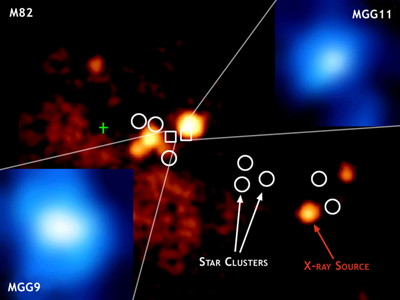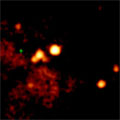April 10, 2004
University of Amsterdam

Chandra X-ray image of the relevant part of M82 with the observed star clusters indicated. The color image is from the 28 October 1999 X-ray observation by Matsumoto et al (2001). The brightest X-ray source (M82 X-1) is near the center of the image. The star clusters are indicated by circles. The positions of the two star clusters MGG-9 and MGG-11 are indicated with squares. The magnified infrared images of these star clusters from McCrady et al (2003) observations are presented in the upper right (MGG-11) and lower left (MGG-9) corners.
New research, funded by the Royal Netherlands Academy of Sciences, the Institute of Advanced Physical and Chemical Research, NASA and the University of Tokyo, solved the mystery of how a black hole, with the mass more than several hundreds times larger than that of our Sun, could be formed in the nearby starburst galaxy, M82.
Recent observations of the Chandra X-ray observatory (Matsumoto et al., 2001 ApJ 547, L25) indicate the presence of an unusually bright source in the star cluster MGG11 in the starburst galaxy M82. The properties of the X-ray source are best explained by a black hole with a mass of about a thousand times the mass of the Sun, placing it intermediate between the relatively small (stellar mass) black holes in the Milky way Galaxy and the supermassive black holes found in the nuclei of galaxies. For comparison, stellar-mass black holes are only a few times more massive than the Sun, whereas the black hole in the center of the Milky-way Galaxy is more than a few million times more massive than the Sun.
An international team of researchers, using the world's fastest computer, the GRAPE-6 system in Japan, were engaged in a series of simulations of star clusters that resembled MGG11. They used the GRAPE-6 to perform simulations with two independently developed computer programs (Starlab and NBODY4 developed by Sverre Aarseth in Cambridge), both of which give the same qualitative result. The simulations ware initiated by high resolution observations of the star cluster MGG11 by McCrady et al (2003, ApJ 596, 240) using the Hubble Space Telescope and Keck, and by Harashima et al (2001) using the giant Subaru telescope.
The GRAPE's detailed, star-by-star simulations represent the state of the art in cluster modeling. For the first time using the GRAPE, researchers perform simulations of the evolution of young and dense star clusters with up to 600000 stars; they calculate the orbital trajectory and the evolution of each star individually. Using this unique tool, the team found they could reproduce the observed characteristics of the star cluster MGG11. As a bonus, however, the star cluster produces a black hole with a mass between 800 and 3000 times the mass of the Sun. The black hole is produced within 4 million years which is in an early phase in the evolution of the star cluster. During this phase the stellar density in the center becomes so high that physical collisions between the stars become frequent. If the stellar densities exceed a million times the density in the neighborhood of the Sun, collision start to dominate the further evolution of the star cluster.
In this over-dense cluster center, stars experience repeated collisions with each other, resulting in a collision runaway in which a single stars grows to enormous mass. After the central fuel of this star is exhausted, it collapses to a black hole of about 1000 times the mass of the Sun.
New results of these detailed computer simulations, published in Nature show that the star cluster in which the X-ray source resides has characteristics such that a black hole of 800-3000 times the mass of the Sun can form within a very short time. The calculations therewith provide compelling evidence for the process which produces intermediate mass black holes and at the same time provide an explanation for the bright X-ray source observed in the cluster.
The GRAPE team's members are Simon Portegies Zwart, from the University of Amsterdam in the Netherlands; Holger Baumgardt, from RIKEN in Tokyo; Piet Hut, of the Institute for Advanced Study in Princeton, N.J.; Jun Makino from Tokyo University; Steve McMillan, from Drexel University in Philadelphia.
The GRAPE group's results appear in the April 15, 2004, issue of Nature.
Relevant internet addresses:
http://www.astrogrape.org
http://www.manybody.org
http://www.manybody.org/manybody/starlab.html



